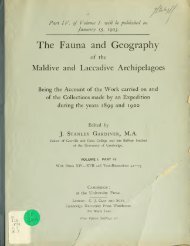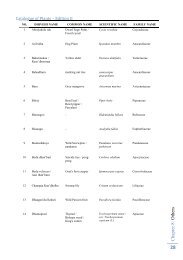Download - WordPress – www.wordpress.com
Download - WordPress – www.wordpress.com
Download - WordPress – www.wordpress.com
You also want an ePaper? Increase the reach of your titles
YUMPU automatically turns print PDFs into web optimized ePapers that Google loves.
THE ENTEROPNEUSTA. 655length.The cornua of the nuchal skeleton are short, extending over less than i of the collarTrunk. The branchial region is fairly long, averaging more than double the length ofthe collar in 10 specimens (see Table 12, p. 673). In one small specimen only was itless than double the length of the collar. On the whole it is remarkably constant in length.The branchial division of the cEsophagus is considerably less than the ventral portion. Thepost-branchial canal was found to be short in the specimen examined, being less than ^ ofthe length of the branchial region. The post-branchial pre-hepatic genital tract is <strong>com</strong>parativelyshort. The genital pleurae are well-develojied.Ptychodera flava, van cooperi (PL XXXVIII. fig. 12; PI. XLV. figs. 4.5—47).LOCALITV, ETC. Two specimens, both somewhat imperfect, from N. Male Atoll. Dredgedin 5 fathoms on a sandy bottom within the velu of Jaro near Helengeli.External features. A small form with a maximum breadth in the collar and branchialregion of less than 3 mm. Behind the hepatic region the diameter of the animal is onlya trifle over 1 mm. In the preserved specimens the collar and proboscis are both very short,their width being greater than their length (PL XXXVIII. fig. 12). The genital pleuraeare large in the branchial region, which is rather more than double the length of the collar.The genital region between the termination of the branchial and the <strong>com</strong>mencement of thehepatic caeca is relatively long. The hepatic caeca are short but well-developed, and ontheir inner sides are lobulated. There is no distinction into lighter and darker ones.Internalstructure.Proboscis. The cavity of the proboscis is well-developed in one specimen, whilst inthe other it is small. The radial an-angement of the muscles is not so conspicuous as inmost members of the genus. Dorso-ventral muscles anterior to the pericardium are notpresent, and the ventral proboscis septum is very short. The right proboscis pore in eachcase places the dorsal coelom in <strong>com</strong>munication with the exterior. The left pore is presentin one .specimen but absent in the other. The racemose organ is well-marked but unlobulated.The keel of the nuchal skeleton is somewhat larger than usually obtains in the species(PI. XLV. fig. 45). The skeleton is altogether massive (PL XLV. fig. 46).Collar. The cavity in the anterior part of the collar is very spacious. Posterior toit the collar musculature is unusually strongly developed, a fact which may in some measureaccount for the extreme shortening of this region on preservation. The dorsal septum isas usual <strong>com</strong>plete after the first root. A ventral septum was <strong>com</strong>pletely absent in onespecimen though traces of it occurred at the extreme hind end of the collar in the other.In one case a single dorsal root reaching to the epidermis was found. In the secondspecimen this was supplemented by a rudimentary one. The lumen of the collar cord shewsa tendency to occlusion behind the level where the roots <strong>com</strong>e otf.A noteworthy feature of this variety is the condition of the nuchal cornua which extendback to the hind end of the collar, the tip of them being found in sections which alsopass through the first branchial bars. Such a condition is most unusual amongst thePtychoderidae, recalling that recently described by Ritter ('OO, p. 113) for Harrimaniamaculosa.Trunk. The branchial portion of the oesophagus is rather larger than the ventral portion.Seven to eight synapticula are present. The post-branchial groove is large (PL XLV. fig. 47),84—2






